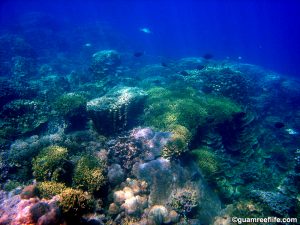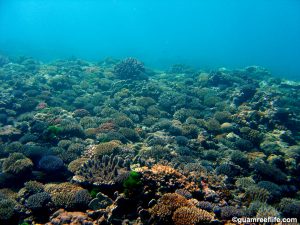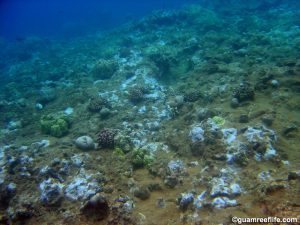The health of Guam’s reefs is highly variable, with many reefs showing signs of severe degradation, while others support diverse, relatively healthy reef communities. Although long term monitoring efforts have only begun relatively recently (with the exception of the Department of Agriculture’s creel monitoring), and it is difficult to objectively assess the health of Guam’s reefs and how the condition of the reefs has changed over time, data collected over the last decade show significant declines in the amount of living coral on Guam’s reefs. For example, between 2013 and 2014 Guam lost nearly half of all of its staghorn coral, and between 2003 and the present the percentage of living coral along the east side of the island has declined from about 20% to less than 10%. A limited amount of available historical data suggest the the decline began decades ago and is of an even greater magnitude, with coral cover reported at around 50% in the 1960s. In addition, the catch per unit effort for reef fish dropped precipitously in the 1980s and reef fish catches are estimated to have declined by up to 86% since the 1950s.
While we don’t have as much as data as we would like, even a conservative assessment of the overall health of Guam’s reefs based on the available data – especially in comparison to reefs in the past – would suggest that many of Guam’s reefs are not doing very well. Unfortunately, Guam’s reefs are not unique in this regard – the decline in the health of Guam’s reefs over at least the last several decades parallels the decline in the health of coral reefs across the Indo-Pacific. As a result of this decline, the ability of Guam’s coral reefs to provide important services to Guam’s current and future residents is compromised.
In the past, Guam’s reefs have recovered after drastic declines, but continued degradation of water quality, chronic crown of thorns sea star outbreaks, low numbers of important herbivorous (algae-eating) fishes and other threats make Guam’s reefs less resilient – meaning they are less able to recover from disturbances such as major storms, major crown of thorns outbreaks, or severe coral bleaching events. A particularly distressing sign of declining reef resilience is the large decrease in rates of coral recruitment (i.e., the settlement of young corals onto the reef) in the last few decades.
Click here to check out a region-by-region overview of the health of Guam’s reefs




